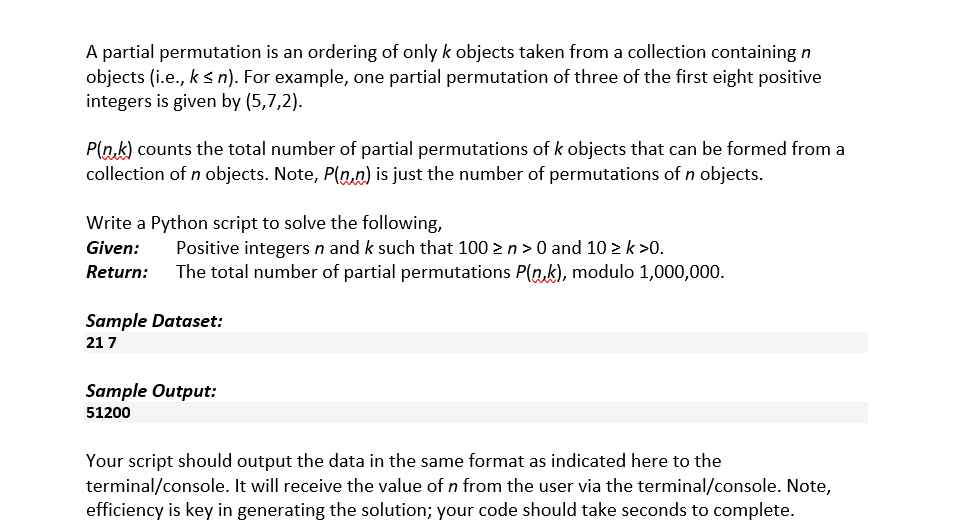A partial permutation is an ordering of only k objects taken from a collection containing n objects (i.e., k s n). For example, one partial permutation of three of the first eight positive integers is given by (5,7,2). P(n,k) counts the total number of partial permutations of k objects that can be formed from a collection of n objects. Note, P(n,n) is just the number of permutations of n objects. Write a Python script to solve the following, Positive integers n and k such that 100 > n > 0 and 10 > k >0. Return: The total number of partial permutations P(ak), modulo 1,000,000. Given: Sample Dataset: 217 Sample Output: 51200
A partial permutation is an ordering of only k objects taken from a collection containing n objects (i.e., k s n). For example, one partial permutation of three of the first eight positive integers is given by (5,7,2). P(n,k) counts the total number of partial permutations of k objects that can be formed from a collection of n objects. Note, P(n,n) is just the number of permutations of n objects. Write a Python script to solve the following, Positive integers n and k such that 100 > n > 0 and 10 > k >0. Return: The total number of partial permutations P(ak), modulo 1,000,000. Given: Sample Dataset: 217 Sample Output: 51200
Database System Concepts
7th Edition
ISBN:9780078022159
Author:Abraham Silberschatz Professor, Henry F. Korth, S. Sudarshan
Publisher:Abraham Silberschatz Professor, Henry F. Korth, S. Sudarshan
Chapter1: Introduction
Section: Chapter Questions
Problem 1PE
Related questions
Question
Please use python and comment on code so I can get a better understanding. If you use any online resources please link them. Thank you.

Transcribed Image Text:A partial permutation is an ordering of only k objects taken from a collection containing n
objects (i.e., k < n). For example, one partial permutation of three of the first eight positive
integers is given by (5,7,2).
P(n.k) counts the total number of partial permutations of k objects that can be formed from a
collection of n objects. Note, P(n,n) is just the number of permutations of n objects.
Write a Python script to solve the following,
Positive integers n and k such that 100 >n>0 and 10 > k >0.
The total number of partial permutations P(n,k), modulo 1,000,000.
Given:
Return:
Sample Dataset:
21 7
Sample Output:
51200
Your script should output the data in the same format as indicated here to the
terminal/console. It will receive the value of n from the user via the terminal/console. Note,
efficiency is key in generating the solution; your code should take seconds to complete.
Expert Solution
This question has been solved!
Explore an expertly crafted, step-by-step solution for a thorough understanding of key concepts.
This is a popular solution!
Trending now
This is a popular solution!
Step by step
Solved in 2 steps

Knowledge Booster
Learn more about
Need a deep-dive on the concept behind this application? Look no further. Learn more about this topic, computer-science and related others by exploring similar questions and additional content below.Recommended textbooks for you

Database System Concepts
Computer Science
ISBN:
9780078022159
Author:
Abraham Silberschatz Professor, Henry F. Korth, S. Sudarshan
Publisher:
McGraw-Hill Education

Starting Out with Python (4th Edition)
Computer Science
ISBN:
9780134444321
Author:
Tony Gaddis
Publisher:
PEARSON

Digital Fundamentals (11th Edition)
Computer Science
ISBN:
9780132737968
Author:
Thomas L. Floyd
Publisher:
PEARSON

Database System Concepts
Computer Science
ISBN:
9780078022159
Author:
Abraham Silberschatz Professor, Henry F. Korth, S. Sudarshan
Publisher:
McGraw-Hill Education

Starting Out with Python (4th Edition)
Computer Science
ISBN:
9780134444321
Author:
Tony Gaddis
Publisher:
PEARSON

Digital Fundamentals (11th Edition)
Computer Science
ISBN:
9780132737968
Author:
Thomas L. Floyd
Publisher:
PEARSON

C How to Program (8th Edition)
Computer Science
ISBN:
9780133976892
Author:
Paul J. Deitel, Harvey Deitel
Publisher:
PEARSON

Database Systems: Design, Implementation, & Manag…
Computer Science
ISBN:
9781337627900
Author:
Carlos Coronel, Steven Morris
Publisher:
Cengage Learning

Programmable Logic Controllers
Computer Science
ISBN:
9780073373843
Author:
Frank D. Petruzella
Publisher:
McGraw-Hill Education